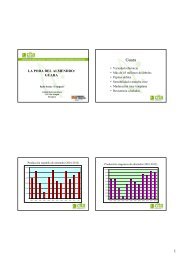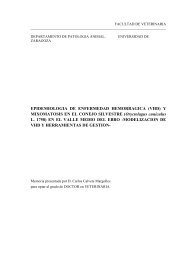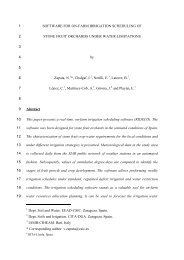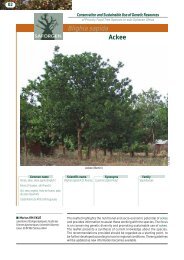1 A Recursive Dynamic Computable General Equilibrium Model For ...
1 A Recursive Dynamic Computable General Equilibrium Model For ...
1 A Recursive Dynamic Computable General Equilibrium Model For ...
You also want an ePaper? Increase the reach of your titles
YUMPU automatically turns print PDFs into web optimized ePapers that Google loves.
nesting to incorporate energy demands follows that employed in the GTAP-E variant<br />
(Burniaux and Truong, 2002) of the well known GTAP global trade model (Hertel, 1997).<br />
The authors provide an insightful overview of differing modelling approaches to energy<br />
substitution. Of particular focus is the close relationship that exists in the literature between<br />
capital and energy demand. <strong>For</strong> this reason, energy goods are removed as intermediate<br />
inputs and transferred into the value added nest. Of particular debate is the issue of<br />
whether capital (i.e., energy using equipment) and energy demands should be represented<br />
as substitutes or complements. In the short run, constraints on energy using capital arise<br />
from technological factors (i.e., ‘lumpy investment’) and adjustment costs. Thus, changes in<br />
energy prices have very little impact on energy using capital goods. However, such ‘rigidy’<br />
factors disappear in the long run such that greater flexibility occurs in capital-energy<br />
substitutability.<br />
Further discussion centers on the separation of electrical and non-electrical forms of<br />
energy. It is noted that grouping all energy forms together risks masking the important<br />
trend of ‘electrification’ in an energy economy as observed in the US between 1960-82<br />
(Burniaux and Truong, 2002, pp7). Moreover, and more pertinently from the point of view<br />
of this study, primary energies (unlike electricity) can also be used as ‘feedstocks’ into<br />
fertilizer usage (rather than consumed as an energy source). In a similar fashion, crude oil is<br />
a feedstock into refined petrol, whilst coke may be used in steel production.<br />
With these developments in mind, the modified representation of the production<br />
nest in the model is presented in Figure 4. Thus, in the top nest of the input demands<br />
structure, a Leontief function is assumed when assigning aggregate expenditures on<br />
composite primary factors and energy (value added), ‘other costs’ and composite nonenergy<br />
commodities. <strong>For</strong> each composite non-energy commodity, an upper and lower<br />
Armington nest is employed to subdivide input expenditures into domestic and composite<br />
imports, and subsequently imports by origin (EU and non-EU source). 10 The ‘value added<br />
and energy nest’ for each industry is a CES aggregate of labour costs, land costs and a<br />
capital-energy composite input. Labour is further subdivided into occupation types<br />
employing a CES substitution elasticity. The capital-energy aggregate input is subdivided<br />
into capital costs per industry and an energy composite input, subject to a CES technology.<br />
10 In the standard ORANI-G model, imports are not disaggregated by source.<br />
11
















